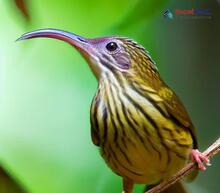The natural world is a magnificent tapestry filled with a diverse array of species. One such fascinating group of creatures is the Arachnothera genus, a collection of birds from the Nectariniidae family, commonly known as sunbirds. These vibrant little feathered creatures have captivated birdwatchers and scientists alike due to their impressive evolutionary adaptations, intricate taxonomy, unique morphology, intriguing ecological relationships, and their presence in Nepal. In this article, we will take a closer look at the wonders of the Arachnothera genus.
Evolution Tree: The Dynamic Origins of Arachnothera
The Arachnothera genus boasts an interesting evolutionary history that displays incredible adaptability in various habitats. These sunbirds emerged in response to alterations in their environment and developed unique traits as they adapted to new niches over time. To fully appreciate their evolution, one needs to examine the ancestral lineage that ultimately gave rise to these fascinating birds. Molecular studies have provided valuable insight into their relationships with other taxa within the Nectariniidae family, illustrating a complex yet elegant web of interconnected lineages.
Taxonomy: Classification and Diversity
Arachnothera comprises several species, which are further divided into multiple subspecies. Taxonomists have made significant strides in understanding the rich diversity within this genus by studying various morphological and molecular features. As a result, researchers have recognized several distinct groups within Arachnothera that share common attributes but differ in key characteristics.
Morphology: Unique Adaptations for Survival
Arachnothera sunbirds display strikingly beautiful plumage with iridescent colors that vary among species and their respective habitats. They possess slender curved bills specifically adapted for feeding on nectar from flowers while hovering. Additionally, their brush-tipped tongues aid in extracting nectar more efficiently. Despite being predominantly nectarivores, these sunbirds also consume small insects and spiders, providing them the name "Arachnothera" or "spider catcher."
Ecology: The Role of Arachnothera in Nature
The complex ecological relationships involving Arachnothera species are vitally important to various ecosystems. When feeding on nectar, these sunbirds unknowingly act as pollinators, transferring pollen from flower to flower, thereby sustaining the life cycle of myriad plant species. Furthermore, their consumption of insects and spiders aids in regulating the population of these invertebrates within their habitat.
Presence in Nepal: A Birdwatcher's Delight
Nepal is home to a thriving biodiversity of birds, making it an excellent location for birdwatching enthusiasts and scientists alike. Among this stunning variety of avian species, the presence of Arachnothera sunbirds adds a unique charm and allure. One can experience the delightful sight of these iridescent birds flitting through lush foliage, feeding on nectar from vivid flowers while playing an integral role in maintaining the ecological balance of Nepal's rich natural environment.
In conclusion, the Arachnothera genus invites us on an enthralling journey through evolution, taxonomy, morphology, and ecology. These sunbirds' captivating beauty and their vital role in maintaining ecological equilibrium make them a remarkable subject for study and admiration. Next time you find yourself exploring the vast natural wonders of Nepal or delving into the depths of ornithological research, remember the exquisite Arachnothera genus and its fascinating story.




